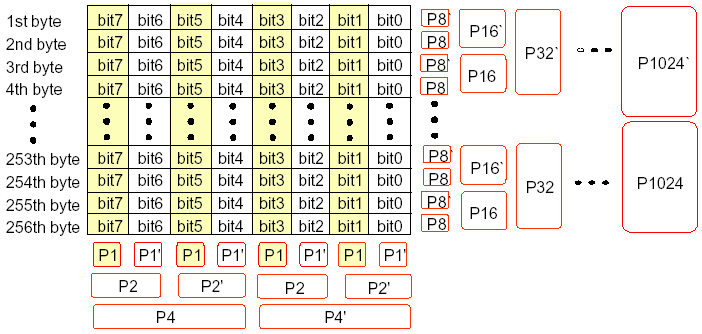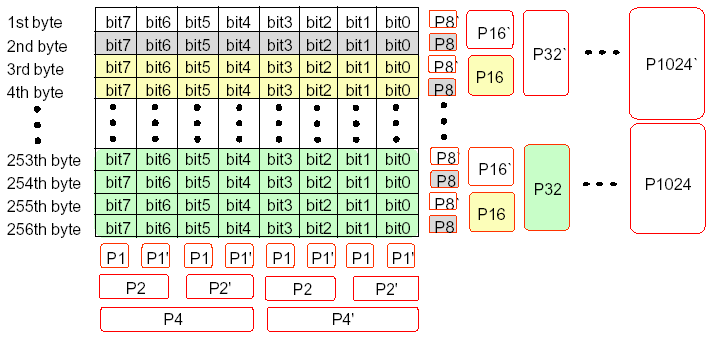NAND FLASH ECC校验原理与实现
ECC简介
由于NAND Flash的工艺不能保证NAND的Memory Array在其生命周期中保持性能的可靠,因此,在NAND的生产中及使用过程中会产生坏块。为了检测数据的可靠性,在应用NAND Flash的系统中一般都会采用一定的坏区管理策略,而管理坏区的前提是能比较可靠的进行坏区检测。
如果操作时序和电路稳定性不存在问题的话,NAND Flash出错的时候一般不会造成整个Block或是Page不能读取或是全部出错,而是整个Page(例如512Bytes)中只有一个或几个bit出错。
对数据的校验常用的有奇偶校验、CRC校验等,而在NAND Flash处理中,一般使用一种比较专用的校验——ECC。ECC能纠正单比特错误和检测双比特错误,而且计算速度很快,但对1比特以上的错误无法纠正,对2比特以上的错误不保证能检测。
ECC原理
ECC一般每256字节原始数据生成3字节ECC校验数据,这三字节共24比特分成两部分:6比特的列校验和16比特的行校验,多余的两个比特置1,如下图所示:

ECC的列校验和生成规则如下图所示:


用数学表达式表示为:
P4=D7(+)D6(+)D5(+)D4 P4`=D3(+)D2(+)D1(+)D0
P2=D7(+)D6(+)D3(+)D2 P2`=D5(+)D4(+)D1(+)D0
P1=D7(+)D5(+)D3(+)D1 P1`=D6(+)D4(+)D2(+)D0
这里(+)表示“位异或”操作
ECC的行校验和生成规则如下图所示:

用数学表达式表示为:
P8 = bit7(+)bit6(+)bit5(+)bit4(+)bit3(+)bit2(+)bit1(+)bit0(+)P8
……………………………………………………………………………………
这里(+)同样表示“位异或”操作
当往NAND Flash的page中写入数据的时候,每256字节我们生成一个ECC校验和,称之为原ECC校验和,保存到PAGE的OOB(out-of-band)数据区中。
当从NAND Flash中读取数据的时候,每256字节我们生成一个ECC校验和,称之为新ECC校验和。
校验的时候,根据上述ECC生成原理不难推断:将从OOB区中读出的原ECC校验和新ECC校验和按位异或,若结果为0,则表示不存在错(或是出现了ECC无法检测的错误);若3个字节异或结果中存在11个比特位为1,表示存在一个比特错误,且可纠正;若3个字节异或结果中只存在1个比特位为1,表示OOB区出错;其他情况均表示出现了无法纠正的错误。
ECC算法的实现
static const u_char nand_ecc_precalc_table[] =
{
0x00, 0x55, 0x56, 0x03, 0x59, 0x0c, 0x0f, 0x5a, 0x5a, 0x0f, 0x0c, 0x59, 0x03, 0x56, 0x55, 0x00,
0x65, 0x30, 0x33, 0x66, 0x3c, 0x69, 0x6a, 0x3f, 0x3f, 0x6a, 0x69, 0x3c, 0x66, 0x33, 0x30, 0x65,
0x66, 0x33, 0x30, 0x65, 0x3f, 0x6a, 0x69, 0x3c, 0x3c, 0x69, 0x6a, 0x3f, 0x65, 0x30, 0x33, 0x66,
0x03, 0x56, 0x55, 0x00, 0x5a, 0x0f, 0x0c, 0x59, 0x59, 0x0c, 0x0f, 0x5a, 0x00, 0x55, 0x56, 0x03,
0x69, 0x3c, 0x3f, 0x6a, 0x30, 0x65, 0x66, 0x33, 0x33, 0x66, 0x65, 0x30, 0x6a, 0x3f, 0x3c, 0x69,
0x0c, 0x59, 0x5a, 0x0f, 0x55, 0x00, 0x03, 0x56, 0x56, 0x03, 0x00, 0x55, 0x0f, 0x5a, 0x59, 0x0c,
0x0f, 0x5a, 0x59, 0x0c, 0x56, 0x03, 0x00, 0x55, 0x55, 0x00, 0x03, 0x56, 0x0c, 0x59, 0x5a, 0x0f,
0x6a, 0x3f, 0x3c, 0x69, 0x33, 0x66, 0x65, 0x30, 0x30, 0x65, 0x66, 0x33, 0x69, 0x3c, 0x3f, 0x6a,
0x6a, 0x3f, 0x3c, 0x69, 0x33, 0x66, 0x65, 0x30, 0x30, 0x65, 0x66, 0x33, 0x69, 0x3c, 0x3f, 0x6a,
0x0f, 0x5a, 0x59, 0x0c, 0x56, 0x03, 0x00, 0x55, 0x55, 0x00, 0x03, 0x56, 0x0c, 0x59, 0x5a, 0x0f,
0x0c, 0x59, 0x5a, 0x0f, 0x55, 0x00, 0x03, 0x56, 0x56, 0x03, 0x00, 0x55, 0x0f, 0x5a, 0x59, 0x0c,
0x69, 0x3c, 0x3f, 0x6a, 0x30, 0x65, 0x66, 0x33, 0x33, 0x66, 0x65, 0x30, 0x6a, 0x3f, 0x3c, 0x69,
0x03, 0x56, 0x55, 0x00, 0x5a, 0x0f, 0x0c, 0x59, 0x59, 0x0c, 0x0f, 0x5a, 0x00, 0x55, 0x56, 0x03,
0x66, 0x33, 0x30, 0x65, 0x3f, 0x6a, 0x69, 0x3c, 0x3c, 0x69, 0x6a, 0x3f, 0x65, 0x30, 0x33, 0x66,
0x65, 0x30, 0x33, 0x66, 0x3c, 0x69, 0x6a, 0x3f, 0x3f, 0x6a, 0x69, 0x3c, 0x66, 0x33, 0x30, 0x65,
0x00, 0x55, 0x56, 0x03, 0x59, 0x0c, 0x0f, 0x5a, 0x5a, 0x0f, 0x0c, 0x59, 0x03, 0x56, 0x55, 0x00
};
// Creates non-inverted ECC code from line parity
static void nand_trans_result(u_char reg2, u_char reg3,u_char *ecc_code)
{
u_char a, b, i, tmp1, tmp2;
/* Initialize variables */
a = b = 0x80;
tmp1 = tmp2 = ;
/* Calculate first ECC byte */
; i < ; i++)
{
if (reg3 & a) /* LP15,13,11,9 --> ecc_code[0] */
tmp1 |= b;
b >>= ;
if (reg2 & a) /* LP14,12,10,8 --> ecc_code[0] */
tmp1 |= b;
b >>= ;
a >>= ;
}
/* Calculate second ECC byte */
b = 0x80;
; i < ; i++)
{
if (reg3 & a) /* LP7,5,3,1 --> ecc_code[1] */
tmp2 |= b;
b >>= ;
if (reg2 & a) /* LP6,4,2,0 --> ecc_code[1] */
tmp2 |= b;
b >>= ;
a >>= ;
}
/* Store two of the ECC bytes */
ecc_code[] = tmp1;
ecc_code[] = tmp2;
}
// Calculate 3 byte ECC code for 256 byte block
void nand_calculate_ecc (const u_char *dat, u_char *ecc_code)
{
u_char idx, reg1, reg2, reg3;
int j;
/* Initialize variables */
reg1 = reg2 = reg3 = ;
ecc_code[] = ecc_code[] = ecc_code[] = ;
/* Build up column parity */
; j < ; j++)
{
/* Get CP0 - CP5 from table */
idx = nand_ecc_precalc_table[dat[j]];
reg1 ^= (idx & 0x3f);
/* All bit XOR = 1 ? */
if (idx & 0x40) {
reg3 ^= (u_char) j;
reg2 ^= ~((u_char) j);
}
}
/* Create non-inverted ECC code from line parity */
nand_trans_result(reg2, reg3, ecc_code);
/* Calculate final ECC code */
ecc_code[] = ~ecc_code[];
ecc_code[] = ~ecc_code[];
ecc_code[] = ((~reg1) << ) | 0x03;
}
// Detect and correct a 1 bit error for 256 byte block
int nand_correct_data (u_char *dat, u_char *read_ecc, u_char *calc_ecc)
{
u_char a, b, c, d1, d2, d3, add, bit, i;
/* Do error detection */
d1 = calc_ecc[] ^ read_ecc[];
d2 = calc_ecc[] ^ read_ecc[];
d3 = calc_ecc[] ^ read_ecc[];
)
{
/* No errors */
;
}
else
{
a = (d1 ^ (d1 >> )) & 0x55;
b = (d2 ^ (d2 >> )) & 0x55;
c = (d3 ^ (d3 >> )) & 0x54;
/* Found and will correct single bit error in the data */
if ((a == 0x55) && (b == 0x55) && (c == 0x54))
{
c = 0x80;
add = ;
a = 0x80;
; i<; i++)
{
if (d1 & c)
add |= a;
c >>= ;
a >>= ;
}
c = 0x80;
; i<; i++)
{
if (d2 & c)
add |= a;
c >>= ;
a >>= ;
}
bit = ;
b = 0x04;
c = 0x80;
; i<; i++)
{
if (d3 & c)
bit |= b;
c >>= ;
b >>= ;
}
b = 0x01;
a = dat[add];
a ^= (b << bit);
dat[add] = a;
;
}
else
{
i = ;
while (d1)
{
if (d1 & 0x01)
++i;
d1 >>= ;
}
while (d2)
{
if (d2 & 0x01)
++i;
d2 >>= ;
}
while (d3)
{
if (d3 & 0x01)
++i;
d3 >>= ;
}
)
{
/* ECC Code Error Correction */
read_ecc[] = calc_ecc[];
read_ecc[] = calc_ecc[];
read_ecc[] = calc_ecc[];
;
}
else
{
/* Uncorrectable Error */
;
}
}
}
/* Should never happen */
;
}
NAND FLASH ECC校验原理与实现的更多相关文章
- ECC校验原理以及在Nand Flash中的应用
本篇文章主要介绍ECC基本原理以及在Nand Flash中的应用,本文记录自己对ECC校验原理的理解和学习. ECC介绍 ECC,全称为Error Correcting Code, ...
- Nand Flash 控制器工作原理
对 Nand Flash 存储芯片进行操作, 必须通过 Nand Flash 控制器的专用寄存器才能完成.所以,不能对 Nand Flash 进行总线操作.而 Nand Flash 的写操作也必须块方 ...
- Nand flash 芯片工作原理
Nand flash 芯片型号为 Samsung K9F1208U0B,数据存储容量为 64MB,采用块页式存储管理.8 个 I/O 引脚充当数据.地址.命令的复用端口. 芯片内部存储布局及存储操作特 ...
- NAND FLASH 原理
NAND FLASH 原理 http://www.360doc.com/content/12/0522/21/21412_212888167.shtml 闪存保存数据的原理: 与DRAM以电容作为存储 ...
- nand flash详解及驱动编写
https://www.crifan.com/files/doc/docbook/linux_nand_driver/release/html/linux_nand_driver.html#nand_ ...
- 如何编写linux下nand flash驱动-4
2. 软件方面 如果想要在Linux下编写Nand Flash驱动,那么就先要搞清楚Linux下,关于此部分的整个框架.弄明白,系统是如何管理你的nand flash的,以及,系统都帮你做 ...
- DM365视频处理流程/DM368 NAND Flash启动揭秘
出自http://blog.csdn.net/maopig/article/details/7029930 DM365的视频处理涉及到三个相关处理器,分别是视频采集芯片.ARM处理器和视频图像协处理器 ...
- Nand flash 三种类型SLC,MLC,TLC【转】
转自:https://blog.csdn.net/fc34235/article/details/79584758 转载自:http://diy.pconline.com.cn/750/7501340 ...
- DM368 NAND Flash启动
概要: 本文介绍了DM368 NAND Flash启动的原理,并且以DM368 IPNC参考设计软件为例,介绍软件是如何配合硬件实现启动的. 芯片上电后是如何启动实现应用功能的?这是许多工程师在看到 ...
随机推荐
- ecshop二次开发之购物车常见问题
1.ecshop二次开发中保存注册用户购物车数据解决方法:ecshop购物车是数据库中cart表来支持的,在ecshop表中rec_id是编号,user_id是注册用户的id,session_id表示 ...
- js点击更多显示更多内容效果
我写了一个简单的分段显示插件,用法很简单:1,把你要分面显示的内容的容器元素增加一个class=showMoreNChildren,并增加一个自定义属性pagesize="8" 这 ...
- C#文本文件或其他文件新内容追加
以txt文本为例,以下代码实现a.txt文件中追加内容 FileStream mystream = new FileStream("C:\\a.txt", FileMode.Ope ...
- 考察printf函数返回值
最近偶然间见了这样一道题: #include<stdio.h> int main() { ; printf("%d\n",printf("%d", ...
- PHP学习之数据库操作
PHP数据库操作: 一.连接数据库 mysql_connect() 例:$link=mysql_connent("localhost","root"," ...
- gcc编译器对宽字符的识别
最早是使用VC++工具来学习C++,学的越多就越对VC挡住的我看不见的东西好奇,总想多接触一些开发环境,今日抽空摸索了一下CodeBlocks这个开源的IDE使用方法,配置的编译器是MinGW的gcc ...
- Crossing River poj1700贪心
题目描述:N个人过河,只有一只船,最多只能有两人划船,每个人划船速度不同,船速为最慢的人的速度.输入T为case个数,每个case输入N为人数,接下来一行输入的是每个人过河的时间,都不相同.要求输出N ...
- DOM4J读取XML文件
最近在做DRP的项目,其中涉及到了读取配置文件,用到了DOM4J,由于是刚开始接触这种读取xml文件的技术,好奇心是难免的,于是在网上又找了一些资料,这里就结合找到的资料来谈一下读取xml文件的4中方 ...
- eclipse 修改编码
在Eclipse的开发使用中,我们经常使用的是UTF-8,但是刚刚安装的或者是导入的项目是其他编码的默认是GBK的,这就造成我们的项目乱码,一些中文解析无法查看,对我们的开发造成不便. 工具/原料 E ...
- 权威指南学习心得-浏览器中的js
window对象:表示web了浏览器的一个窗口或窗体(winow属性引用自身) 含有以下属性:location包含Location对象,指定当前显示在窗口中URL,允许脚本往窗口里载入新的URL 含有 ...
